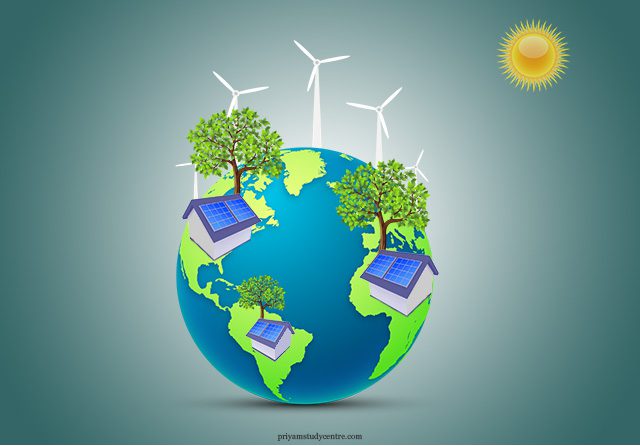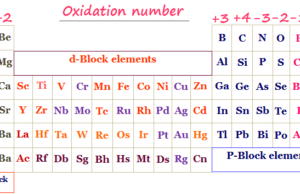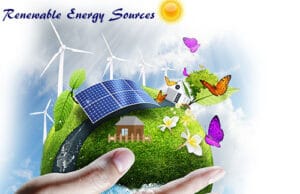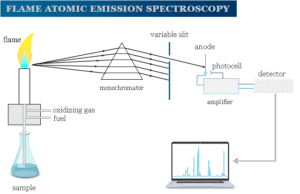Energy Sources and Types
Energy in physics or chemistry is defined as a property that can be transformed into or produced from work. Kinetic and potential are the main types of energy that are important in learning chemistry or physics. These two categories are sufficient to describe all forms of energy such as mechanical, internal, chemical, heat, electromagnetic, surface tension, and ionization energy. The conservation of energy states that energy can neither be created nor be destroyed but it may transfer one form to another. It can be obtained from different types of non-renewable or renewable resources which are converted into other forms for doing useful work.

The energy contained in fuel or food is calculated by measuring heat produced by the combustion of a specific quantity of food and fuel. It is measured most commonly by SI unit joule and CGS unit erg. The other most common units are calorie (cal), British thermal unit (Btu), electronvolt (ev), kilowatt-hours (kWh), and kilocalories (kcal).
In the biological system, energy is important for the growth and development of living organisms. It is stored in substances such as carbohydrates, lipids, and proteins. Therefore, various biological processes in living organisms are carried out in the presence of food and oxygen.
Types of Energy Sources
A natural source of energy is anything that comes from nature and is used to fulfill our daily needs. Examples of natural resources are air, wood, oil, wind power, hydroelectric power, coal, etc. According to sources, such resources are two types such as non-renewable and renewable energy resources.
Non Renewable Energy Resources
Oil, natural gas, coal, and nuclear power are the four major types of non-renewable natural energy resources. We use such resources widely in our daily lives for fueling vehicles and heating homes. From these four, oil, natural gas, and coal are collectively named fossil fuels. Most of the electricity in your home comes from a power plant that uses fossil fuels.
These resources are obtained due to the decomposition of dead plants and animals over millions of years. These are mainly hydrocarbon compounds. The demands for fossil fuels are beyond our control because they make our lives easier.
These resources are non-renewable. Therefore, once the resources are depleted, we will not be able to obtain any more coal, natural gas, or petroleum oil. The use of coal creates environmental problems by emitting huge amounts of carbon dioxide gas. The other resources such as petroleum oil and natural gas also cause environmental hazards.
Renewable Energy Sources
Renewable resources are present in unlimited quantities in nature and replenished naturally. Therefore, currently, we finding alternate renewable sources of energy due to the small reserves of fossil fuels on our earth.
The renewable sources that we use commonly for the production of electricity or generation of heat may include:
- Wind Energy: It is a renewable source that is extracted from air flow using wind turbines or sails. Commonly, we use wind flow to generate mechanical power or electricity.
- Solar Energy: It is a type of renewable source obtained from the electromagnetic radiation of the Sun and used for the production of electricity and generating heat.
- Geothermal Energy: It is a renewable source that is generated by utilizing the heat of the interior earth. It can be used for space heating or for boiling water and generating streams to drive turbogenerators.
- Hydropower: It is one of the oldest and largest renewable sources which is used for generating electricity from the natural flow of moving water.
- Biogas: The word ‘Biomass’ refers to organic matter that has stored energy through the process of photosynthesis. It is an excellent fuel that contains a high percentage of methane gas.
These types of resources we used mainly to save fossil fuels, less environmental pollution, and huge demand for electricity all over the world. We commonly convert these primary energy sources for generating electricity (secondary sources) and transmit it to homes and factories.
Heat Energy
Heat or specific heat is another form of energy that can produce work and transfer from one body to another. But heat is different from other energies such as chemical, mechanical, or electrical. All the other energies are completely converted into work but heat cannot be wholly converted into work.
In learning chemistry or physics, when two objects with different temperatures come together, heat transit or flows from lower temperatures to higher temperatures. For example, a refrigerator uses electricity to transfer heat from a lower temperature to a higher temperature.
More precise examples of conversion of energy into work or heat are the burning of coal or natural gas for doing some useful work. The mechanical work spent by rubbing two crystalline solid blocks of ice generates a quantity of heat. Therefore, there is an intimate relationship between heat and work. One can yield the other quantity.
Heat is an extensive thermodynamics property like volume or surface area because it depends on the mass of the system. On the other hand, intensive properties like temperature, pressure, density, and refractive index are independent of the mass of the system.
Kinetic and Potential Energy
Kinetic energy (KE) and potential are two types of energies that can be converted to each other by various common processes. These two categories are sufficient to describe all forms of energy such as mechanical, electrical, rotational, chemical, electromagnetic, ionization, thermal, etc.
The phenomenon where one form of energy can be converted into another form is called the transformation of energy. The examples of transformation of these two types of energies are:
- When an object is dropped from some height, its PE is continuously converted into KE.
- Similarly, when an object is thrown upward, its KE is continuously converted into PE.
Kinetic Energy
The kinetic energy (KE) is the type of energy that is produced due to the motion of objects. It can be defined by accelerating a given mass of the body from rest to an appropriate speed and calculated by SI unit joule (J). Due to KE, a bullet fired from a gun can pierce a target and a moving hammer drives a nail into the wood.
Three types of motions such as rotational, vibrational, and translational may create KE in an object. The kinetic energy of the non-rotating body can be calculated by the following formula,
KE = mv2/2
Here, m = mass of the non-rotating body
v = speed of the body in a given time
The accelerating bodies maintain their kinetic energies unless their velocity changes. The above formula is valid from low to relatively high speed.
Potential Energy
The potential energy (PE) formula in science was described first by 19th-century Scottish engineer and physicist William Rankine to define various forms of potential energies held by an object. It is a stored energy that can depend upon the relative position of the various parts of a system.
Gravitational, elastic, and electric energies are the common types or forms of PE and the SI unit of PE is the joule (J). The common examples of PE are displacing the spring from its equilibrium position, lifting the weight, and turning the blades in the wheel.
Gravitational Potential Energy
Consider an object of mass m, lying at point A on the Earth’s surface. Here, its PE is zero and its weight mg acts vertically downwards.
For lifting such an object at a height of h, we need to apply a minimum force that is equal to mg in an upward direction. So, work is done on the body against the force of gravity.
From definition, work done = Force × Displacement
W = F × s = mg × h (here, F = mg and s = h)
Therefore, W = mgh
The work done (W) is equal to the gain in energy of the body. Therefore, gravitational potential energy can be calculated by the formula,
PE = mgh
where g = gravity of earth = 9.80665 m s−2
The work done by gravity depends on the difference in vertical heights of the initial and final positions of the objects and not on the path along which the object moved.
Unit of Work, Energy, and Power
They are derived from physical quantities whose units can be derived from other base physical quantities like mass, length, and time. The units and dimensions of work, energy, and power may be expressed in terms of base physical quantities by multiplication and division.
Unit of Work
From the definition of work,
Work done = force Displacement in the direction of force
W = F × s
If F = 1 N and s = 1 m, then the work done by the force will be 1 N-m. The SI unit of work is newton-metre (N-m) or joule (J).
Therefore, 1 J is the amount of work done on an object when a force of 1 N displaces it by 1 m along the line of action of the force.
∴ 1 joule = 1 newton × 1 metre
or, 1 J = 1 N-m
Unit of Energy
From the definition, energy is the ability to do work. Therefore, the unit and dimension of energy and work are the same. It is derived by unit or SI unit joule in honor of James Prescott Joule.
Energies are also expressed by several other units such as ergs, calories, British thermal units, electronvolt, kilowatt-hours, and kilocalories. We require a conversion factor when expressing these units into joule (SI unit).
- 1 erg = 10−7 J
- 1 calorie = 4.184 J
- 1 British thermal unit (Btu or BTU) = 1055 J
- 1 electronvolt = 1.602 × 10−19 J
- 1 kilowatt-hour = 3.6 × 106 J
- 1 kilocalorie = 4184 J
Commercial Unit of Electrical Energy
The unit joule is too small to express a large quantity of energy and a bigger unit is used for expressing such a large quantity. Therefore, a Kilowatt-hour (kWh) or Board of Trade (BOT) unit is used for expressing electricity commercially.
One Kilowatt-hour (kWh) or Board of Trade (BOT) unit is the amount of electricity consumed by an appliance of power 1000 W in one hour.
1 kWh = 1kW × 1 h
= 1000 W × 3600 s
= 1000 J s−1 × 3600 s
Therefore, 1 kWh = 3.6 × 106 J
The electricity used in our monthly bill and industrial bill is expressed in terms of such units. Hence, one unit = 1 kilowatt-hour = 1 BOT = 3.6 × 106 J.
Problem: An electric heater of 1000 W is used for 3 hours a day. How many electric units are consumed in 25 days?
Solution: The electricity consumed in one day,
= 1000 W × 3 h
= 1 kW × 3 h (1000 W = 1 kW) = 3 kWh = 3 units
Therefore, the total electric units consumed in 25 days,
= 3 × 25
= 75 units
Unit of Power
The rate of doing work or the rate at which energy is transferred, or transformed to other forms is called power. If work W is done in time t, then Power (P) = Work (W)/Time (t).
The SI unit of power is the watt ( in honor of James Watt) and has the symbol W. The larger rate of energy transfer is expressed by unit kilowatts (kW), megawatts (MW), and horsepower (HP).
- 1 watt (W) = 1 J s−1
- 1 kilowatts (kW) = 1000 W = 1000 J s−1
- 1 megawatts (MW) = 106 W = 106 J s−1
- 1 horsepower (HP) = 746 W
Problem: The human heart does 1.2 J of work in each heartbeat. How many times per minute does it beat if its power is 4 W?
Solution: Here work done in each heartbeat = 1.2 J
t = 1 min = 60 s
Power (P) = 4 W = 4 J s−1
Total work done by heart = P × t
= 4 × 60
= 240 J
Therefore, the number of heartbeats per minute,
= 240/1.2
= 200 times
Heat and Work
Heat is another form of energy that can be converted into all the other forms like electrical, chemical, mechanical, kinetic, or potential by producing work. The relation between heat and work is the origin of the first law of thermodynamics.
It states that if or whenever heat is obtained from work, the amount of heat produced is proportional to the work spent. In other words, if heat is transferred into work, there is proportionality between the work obtained and heat disappearing.
Conversion of Heat into Work
Heat cannot be completely converted into work because any attempt to convert whole heat into work permanently changes the system or neighboring system. When two objects with different temperatures come together, one with a higher temperature loses heat, and the other gains it.
The production or conversion of heat into work is going through a definite process. When a liquid molecule freezes into a solid, the average energy of molecules decreases. For example, water freezes into ice by decreasing temperature.
Energy Conversion
Energy conversion is a process where one form of energy is converted into another such as electrical, mechanical, kinetic, potential, etc. The common examples of such conversion of energies in our daily used instruments are:
- Electromagnetic to chemical energy: Green plants prepare their own food by using solar electromagnetic radiation through the process of photosynthesis. Here, solar electromagnetic radiation is converted to chemical energy and stored in food.
- Chemical to kinetic energy: When we throw a ball, the muscular energy stored in our body is converted into the kinetic energy of the ball.
- Mechanical energy to electricity: The mechanical work done on the turbine blades of a hydroelectric power plant would generate electricity.
- Chemical energy to electricity: The redox reaction between the chemical elements zinc and copper sulfate produces a large amount of heat. The same chemical change is carried out in electrochemical cell or batteries for the production of electrical current.
- Solar power to electricity: We used solar cells for the production of electricity from light.
Such conversion is carried out by various instruments such as electric motors, blub, generators, stream engines, dry cells, solar cells, etc.
Internal Energy
In thermodynamics, every system has within itself a quantity of internal energy. The heat absorbed or released by a system under constant volume can increase or decrease its internal energy. It can be obtained by common observations,
- A liquid freezes into a solid by releasing heat.
- Zinc and copper sulfate in Daniell cells produce electricity.
- Steam expands from a higher to a lower pressure yielding work or mechanical work.
- Yellow phosphorus glows in oxygen-producing light.
- Carbon monoxide unites with oxygen to produce carbon dioxide and heat.
From these observations, we have a question, how could they yield work or another form of energy by themselves? We thus believe that every system within itself has a quantity of energy. It is called the internal or intrinsic energy of the system denoted by the symbol U. It is an extensive property.
Internal energy changes when a system changes from one thermodynamic state to another thermodynamic state. If UA and UB denote internal energies in two states, then the change (ΔU) = UB − UA. It will be independent of the process or path along which the transformation is carried out.
Frequently Asked Questions – FAQs
Which energy source is renewable?
Wind, solar power, hydropower, geothermal, and biogas are the most useable renewable resources. They are present in unlimited quantities in nature and replenished naturally. These resources are commonly used for the production of electricity or the generation of heat.
The use of such renewable resources may also save our environment from polluting substances emitted from non-renewable resources such as fossil fuels.
What unit is energy measured in?
Most commonly energy will be measured in SI unit joule (J) in honour of the English physicist James Prescott Joule. It is also measured in various other units such as ergs, calories, British thermal units, electronvolt, kilowatt-hours, and kilocalories
What is the unit of power?
Simply, the rate of doing work is called power. Therefore, the unit of power = unit of work/unit of time.
In the SI system, we know, the unit of work is joule and time second (s). Hence, the unit of power in the SI system = J s−1. It is also called watt (W) in honour of physicist James Watt.
We also used kilowatt (kW), megawatt (MW), and horsepower (HP) for measuring larger quantities of power.
What is the unit of work and energy?
From the definition, energy is the ability to do work. Therefore, the unit of energy and work are the same and expressed by unit joule (J) in honour of English physicist James Prescott Joule.
What is the commercial unit of energy?
The commercial unit of energy is the Kilowatt-hour (kWh) or Board of Trade (BOT) unit. The electricity consumed by homes and industries is expressed in terms of kWh or BOT.
How heat is transferred?
Heat is transferred by various processes such as thermal conduction, thermal convection, thermal radiation, and transfer of heat by phase changes.
Heat is also used for doing work. If heat is transferred into work, there is proportionality between the work obtained and heat disappearing.
























